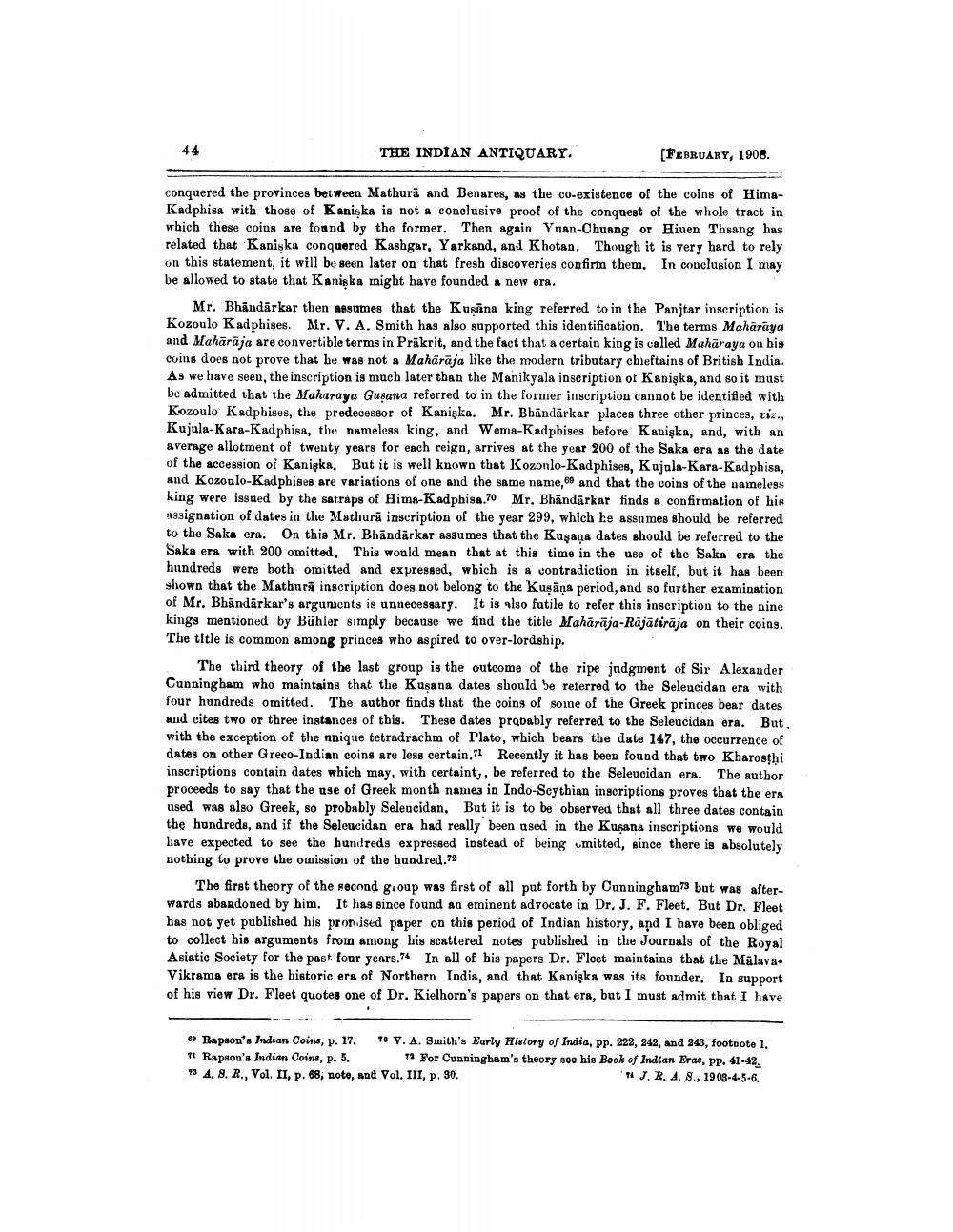________________
44
THE INDIAN ANTIQUARY.
[FEBRUARY, 1908.
conquered the provinces between Mathura and Benares, as the co-existence of the coins of HimaKadphisa with those of Kaniska is not a conclusive proof of the conquest of the whole tract in which these coins are found by the former. Then again Yuan-Chuang or Hiuen Thsang has related that Kaniska conquered Kashgar, Yarkand, and Khotan. Though it is very hard to rely on this statement, it will be seen later on that fresh discoveries confirm them. In conclusion I may be allowed to state that Kanişka might have founded a new era.
Mr. Bhāndārkar then assumes that the Kusāna king referred to in the Panjtar inscription is Kozoulo Kad phises. Mr. V. A. Smith has also supported this identification. The terms Maharaya and Mahārāja are convertible terms in Prakrit, and the fact that a certain king is called Mahāraya on his coins does not prove that he was not a Mahārāja like the modern tributary chieftains of British India. As we have seen the inscription is much later than the Manikyala inscription of Kanişka, and so it must be admitted that the Maharaya Gusana referred to in the former inscription cannot be identified with Kozoulo Kadphises, the predecessor of Kanişka. Mr. Bbändārkar places three other princes, riz., Kujula-Kara-Kadpbisa, the nameless king, and Wema-Kadphises before Kaniska, and, with an average allotment of twenty years for each reign, arrives at the year 200 of the Saka era as the date of the accession of Kanigka. But it is well known that Kozonlo-Kadphises, Kajala-Kara-Kadphisa, and Kozoulo-Kadphises are variations of one and the same name, and that the coins of the nameless king were issued by the satraps of Hima-Kadphisa.70 Mr. Bhändärkar finds a confirmation of his assignation of dates in the Mathurā inscription of the year 299, which he assumes should be referred to the Saka era. On this Mr. Bhāndārkar assumes that the Kuşaņa dates should be referred to the Saka era with 200 omitted. This would mean that at this time in the use of the Saka era the hundreds were both omitted and expressed, which is a contradiction in itself, but it has been shown that the Matburs inscription does not belong to the Kuşāņa period, and so further examination of Mr. Bhāndārkar's arguments is unnecessary. It is also futile to refer this inscription to the nine kings mentioned by Bühler simply because we find the title Mahārāja-Rajātirāja on their coins. The title is common among princes who aspired to over-lordship.
The third theory of the last group is the outcome of the ripe judgment of Sir Alexander Cunningham who maintains that the Kuşana dates should be referred to the Seleucidan era with four hundreds omitted. The author finds that the coins of some of the Greek princes bear dates and cites two or three instances of this. These dates probably referred to the Seleucidan era. But. with the exception of the nnique tetradrachm of Plato, which bears the date 147, the occurrence of dates on other Greco-Indian coins are less certain.71 Recently it has been found that two Kharosthi inscriptions contain dates which may, with certainty, be referred to the Seleucidan era. The author proceeds to say that the use of Greek month names in Indo-Scythian inscriptions proves that the era used was also Greek, so probably Seleucidan, But it is to be observed that all three dates contain the hundreds, and if the Seleucidan era had really been used in the Kuşana inscriptions we would have expected to see the hundreds expressed instead of being umitted, since there is absolutely nothing to prove the omission of the hundred.72
The first theory of the second group was first of all put forth by Cunningham73 but was afterwards abandoned by him. It has since found an eminent advocate in Dr, J. F. Fleet. But Dr. Fleet has not yet published his promised paper on this period of Indian history, and I have been obliged to collect his arguments from among his scattered notes published in the Journals of the Royal Asiatic Society for the past four years.74 In all of bis papers Dr. Fleet maintains that the MälavaVikrama era is the historic era of Northern India, and that Kanişka was its founder. In support of his view Dr. Fleet quotes one of Dr. Kielhorn's Papers on that era, but I must admit that I have
* Rapson's Indian Coins, p. 17. 10 V. A. Smith's Early History of India, Pp. 222, 242, and 243, footnote 1. 11 Rapson's Indian Coins, p. 5. 1 For Cunningham's theory see his Book of Indian Eras, PP. 41-42 *
T 4. 8. R., Vol. II, p. 68, note, and Vol. III, p. 30.
J .R.A. 8., 1909-4-5-6.




